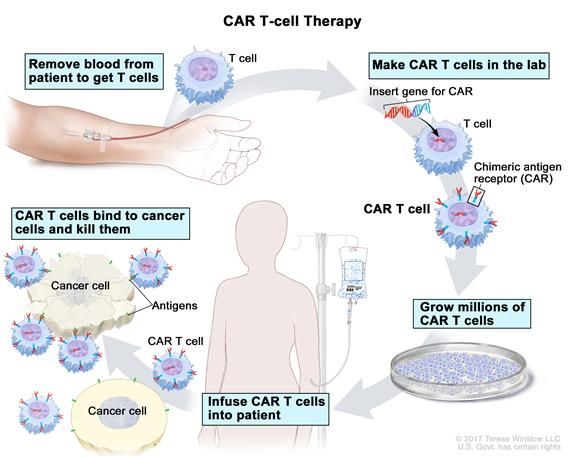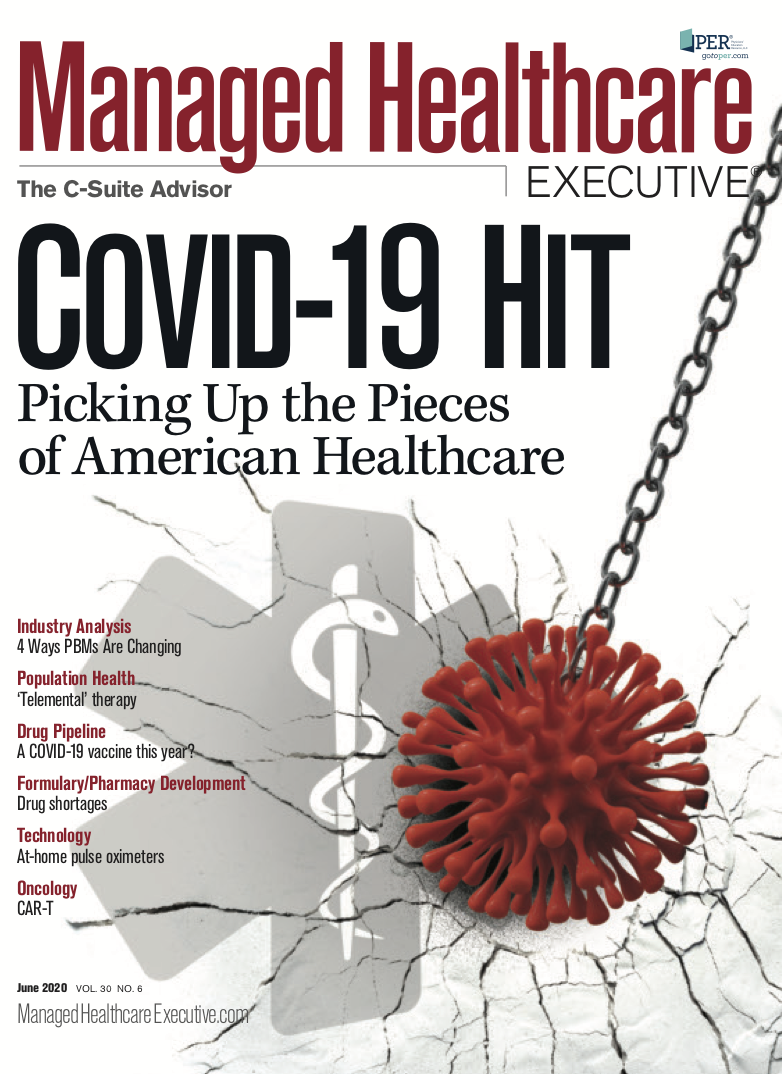5 Developments Changing the CAR-T Landscape
An off-the-shelf version of CAR-T therapy that uses the immune system’s natural killer cells is a possibility. But the high price of CAR-T shows some doubts about how widely it can be used.

The first pillar: surgical excision, which in the beginning was brutal and often disfiguring. In the mid-20th century, chemotherapy and radiation were added. They were also hard on patients as doctors pushed the outer bounds of what people could tolerate to rid the body of cancer. And pillar No. 4: therapies like Gleevec (imatinib), “smart bombs” that targeted the molecular-level underpinnings of cancer cell growth and division.
Now oncologists like Huda Salman, M.D., see immunotherapy as the fifth pillar of a cancer treatment edifice that is accretive and complex. Chimeric antigen receptor T cell (CAR-T) therapy, one of the main forms of immunotherapy, involves genetically engineering the patient’s own T cells so they recognize cancer cells and attack them in the way that unengineered T cells attack invasive organisms.
“Up until now,there have only been very few tumors for which we could use immunotherapy; however, this is where the whole field of treating cancer is going,” says Salman, director of the CAR T Cellular Therapy Program at Stony Brook University Cancer Center in New York.
The FDA has approved two CAR-T therapies, Kymriah (tisagenlecleucel) and Yescarta (axicabtagene ciloleucel). Kymriah is approved as a treatment for a subgroup of pediatric and young adult patients with a form of acute lymphoblastic leukemia (ALL) and for adults with relapsed or refractory diffuse large B-cell lymphoma (DLBCL). Yescarta is approved for four types of non-Hodgkin lymphoma in adult patients who have relapsed or not responded to other treatments: DLBCL, primary mediastinal large B-cell lymphoma, high-grade B-cell lymphoma and DLBCL arising from follicular lymphoma.
The price of CAR-T looms over its promise. The two FDA-approved versions have list prices well over $350,000; physician and hospital charges can easily push the total cost past the million-dollar mark. Payers, providers, and policymakers are puzzling through and arguing about how to possibly shoulder such a huge cost, while researchers continue to tweak the approach in hopes of making it a safe and effective treatment for many cancers — and potentially less costly.
Here are five recent developments in CAR-T therapy:
1.) Potential Competition in CAR-NK
Parameswaran Hari, M.D., MRCP, professor and chief of the division of hematology and oncology at the Cancer Center at Froedtert Hospital in suburban Milwaukee, Wisconsin, says two majordevelopments in CAR-T are the promise it is showing as an effective treatment for mantle cell lymphoma and the trials underway that could lead to it having an allogeneic future. There’s a lot of buzz about CAR therapies that would involve altering the natural killer (NK) cells of the immune system instead of T cells, Hari says. NK cells might have several advantages, partly because they recognize “nonself” cells without antibodies and major histocompatibility complex.
If CAR-NK pans out, clinicians could draw the NK cells from people other than the patient and use them off the shelf rather than in the individualized way that CAR-T requires. “Price will perhaps be lower for allogeneic off-the-shelf CARs, since many steps are not needed and mass production is possible,” notes Hari.
A team of researchers from MD Anderson Cancer Center in Houston
reported the results of a phase 1/2 trial of CAR-NK in the Feb. 6, 2020, issue of the New England Journal of Medicine. The trial included 11 patients with relapsed or refractory cluster of differentiation (CD) 19-positive cancers (non-Hodgkin lymphoma or chronic lymphocytic leukemia). Seven had a complete response, according to the authors, and the treatment was not associated with CAR-T side effects.
“This is very exciting because they didn’t just take natural killer cells from somebody but transduced natural killer cells from cord blood units,” says Guenther Koehne, M.D., Ph.D., deputy director and chief of blood and marrow transplantation and hematologic oncology at Miami Cancer Institute in Florida. By doing that, the researchers may have established an off-the-shelf version of CAR-T, although the moniker might be CAR-NK, not CAR-T.
2.) CD4 T Cells and CD8 T Cells in Equal Measure
Koehne notes that one of the promising developments in CAR-T therapies this year is a new immunotherapeutic approach to treat patients who have relapsed following treatment for lymphoma or whose autologous transplant was unsuccessful. Researchers are testing the approach in a clinical trial, and the Miami Cancer Institute is one of the sites selected to participate, according to Koehne.
The goal is to reduce the side effects of CAR-T cells and extend their duration once administered to the patient, he says. What’s special about this approach is that clinicians select the CD4 T cells and the CD8 T cells separately prior to transducing the cells with the CAR product. In other words, explains Koehne, the CD4 T cells and the CD8 T cells are processed and modified separately and infused into patients in equal amounts.
“This appears to be critical for the duration of CAR T cells in the blood because the first generation of CAR T cells had a dominant CD8 component with few CD4 cells,” Koehne says. “The CD4 (T cells) cells, which are also referred to as helper T cells, are providing support to enable longer duration of the CAR-T cells in the bloodstream and therefore could provide a better outcome.”
Reduction of side effects and time in the hospital could significantly help to reduce the expense, notes Koehne. “The overall costs are then driven by the development of cytokine release syndrome and neurotoxicity, which can easily increase the costs threefold to fourfold, since a high percentage of patients develop these side effects and need to be admitted, often to the ICU,” Koehne says. “Within no time at all, the average treatment costs are in the range of $1.2 to $1.5 million per patient.”
3.) Not Just for Blood Cancers
Chandler Park, M.D., an oncologist at Norton Healthcare in Louisville, Kentucky, believes the biggest development in CAR-T this year will be the treatment’s application to nonblood cancers. “Many leading cancer centers will open up clinical trials for solid tumor cancers such as breast cancer, lung cancer and prostate cancer,” he predicts. He cautions, though, that CAR-T’s cost will be factor in whether patients should receive this treatment. An informed discussion with the patient should include not only the efficacy and medical side effects of the treatment but also the risk of “financial toxicity,” says Park, using a term that oncologists have coined for high cost sharing.
Importantly, says Park, clinicians should recognize that the side effects of CAR-T are unlike the hair loss, nerve pain and low blood counts that sometimes accompany traditional chemotherapy. “The CAR-T treatment revs up the immune system and therefore causes immunotherapy-associated side effects,” Park says. “It is like hitting a beehive with a baseball bat.” The bees in Park’s metaphor are cytokines, the signaling proteins of the immune system, and the swarming, cytokine release syndrome, is one of the most common side effects of CAR-T. The symptoms of cytokine release syndrome range from mild flu-like symptoms to life-threatening, systemic inflammation.
Another major side effect is CAR-T-related encephalopathy syndrome (CRES). CAR-T can produce neurotoxicity that, like cytokine release syndrome, can lead to a range of symptoms, from a mild headache to seizures and even death. The common consequence is encephalopathy (brain damage). People affected by CRES may experience confusion, difficulty speaking (aphasia) and a dulling of consciousness (obtundation).
4.) Impressive Results
Koehne says the results of the treatment for relapsed or refractory non-Hodgkin lymphoma with CAR-T cells are increasingly impressive. “Patients have a good and lasting response, which has been a limitation of initial CAR-T cell studies, which saw a high percentage of responses — up to 90% and in some studies even higher — but the responses didn’t last for too long,” he says. In most cases, additional treatment led to complete remission, and follow-up treatments were needed, says Koehne.
5. ) Multiple Myeloma Next in Line?
The first generation of CAR-T targeted the CD19 surface protein that is expressed on nearly all B-cell cancers, a group that includes chronic lymphocytic leukemia, ALL and many types of non-Hodgkin lymphoma. Now hope exists for a version of CAR-T that would target the B-cell maturation antigen expressed on the malignant plasma cells that characterize multiple myeloma. “The limitation, once again, is that we won’t know how long the responses will last,” says Koehne.
Keith Loria is an award-winning journalist who has been writing for major newspapers and magazines for close to 20 years.

Rutgers Cancer Institute Reviews Guidelines for Managing Blood Cancers During Pregnancy
April 8th 2025About 6% of pregnancy-related cancers are Hodgkin lymphoma, and 5% are non-Hodgkin lymphoma. Leukemias in pregnancy are rarer, accounting for 1 in 10,000 pregnancies. The most common pregnancy-related leukemias are acute myeloid leukemia (AML), acute lymphoblastic leukemia (ALL), and chronic myeloid leukemia (CML).
Read More
CAR T-Cell Therapy Cuts Costs, Reduces Treatment in Mantle Cell Lymphoma
March 13th 2025In a real-world study, researchers found this data by comparing treatment patterns, healthcare resource utilization, and costs between patients receiving CAR T-cell therapy and those treated with the non-CAR T standard of care.
Read More
David Calabrese of OptumRx Talks New Role, Market Insulin Prices and Other Topics 'On His Mind'
April 13th 2023In this month’s episode of the "What's On Your Mind podcast," Peter Wehrwein, managing editor of MHE connects with the now Chief Clinical Officer of OptumRx Integrated Pharmacies, David Calabrese. In this conversation, David touches on his transition in January as OptumRx’s former chief pharmacy officer and market president of health plans and PBMs to his new role as Chief Clinical Officer where he now focuses more on things such as specialty pharmacy to home delivery — with an overall goal of creating whole-patient care. Throughout the conversation, Calabrese also touched on the market’s hot topic of insulin prices and behavioral health services within the OptumRx community, among other topics.
Listen
FDA Approves Tevimbra for Advanced Esophageal Cancer at $15,828 Per Month
March 5th 2025Esophageal squamous cell carcinoma accounts for approximately 90% of all esophageal cancer cases. Projections estimate that by 2040, there will be approximately 957,000 new cases of esophageal cancer worldwide, marking a nearly 60% increase from 2020, according to BeiGene.
Read More